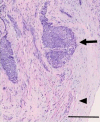Concomitant Pulmonary and Cerebral Tumor Embolism and Intracardiac Metastasis from Bladder Cancer
- PMID: 34120999
- PMCID: PMC8710365
- DOI: 10.2169/internalmedicine.6765-20
Concomitant Pulmonary and Cerebral Tumor Embolism and Intracardiac Metastasis from Bladder Cancer
Abstract
An 82-year-old woman with a history of bladder cancer presented with dyspnea and loss of consciousness. Contrast-enhanced computed tomography revealed pulmonary embolism, and emergency thrombus aspiration therapy was performed, but the thrombus was not aspirated. Echocardiography showed mobile masses in the heart and a right-to-left shunt due to a patent foramen ovale (PFO). Magnetic resonance imaging showed multiple cerebral infarctions. Surgical thrombectomy and PFO closure were performed, and the patient was diagnosed with intracardiac metastasis of bladder cancer based on intraoperative histopathology. This is a rare case of concomitant pulmonary and cerebral tumor embolism and intracardiac metastasis from bladder cancer.
Keywords: intracardiac metastasis; paradoxical embolism; patent foramen ovale; pulmonary artery aspiration cytology; pulmonary tumor embolism.
Conflict of interest statement
Figures





References
-
- Windecker S, Stortecky S, Meier B. Paradoxical embolism. J Am Coll Cardiol 64: 403-415, 2014. - PubMed
-
- Hagen PT, Scholz DG, Edwards WD. Incidence and size of patent foramen ovale during the first 10 decades of life: an autopsy study of 965 normal hearts. Mayo Clin Proc 59: 17-20, 1984. - PubMed
-
- Meissner I, Whisnant JP, Khandheria BK, et al. . Prevalence of potential risk factors for stroke assessed by transesophageal echocardiography and carotid ultrasonography: the SPARC study. Mayo Clin Proc 74: 862-869, 1999. - PubMed
-
- Roberts KE, Bena DH, Saqi A, Stein CA, Cole RP. Pulmonary tumor embolism: a review of the literature. Am J Med 115: 228-232, 2003. - PubMed
-
- Tamura A, Matsubara O. Pulmonary tumor embolism: relationship between clinical manifestations and pathologic findings. Nippon Kyobu Shikkan Gakkai Zasshi (Jpn J of Thorac Dis) 31: 1269-1278, 1993. (in Japanese, Abstract in English). - PubMed

